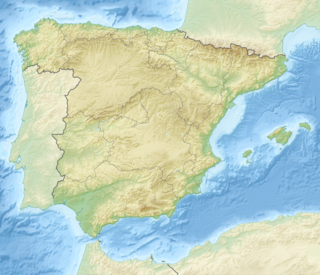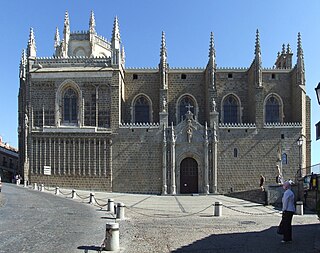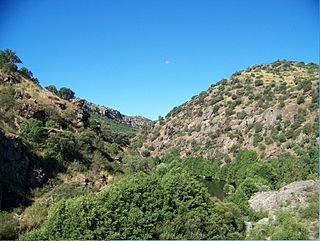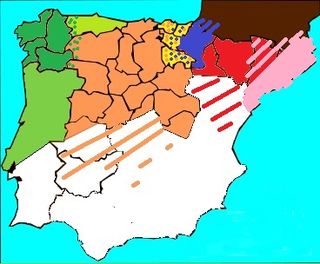
Burgos is a city of Spain located in the autonomous community of Castile and León. It is the capital and most populated municipality of the province of Burgos.

Valladolid is a city in Spain and the capital of the autonomous community of Castile and León. It has a population of 309,714 people, making it Spain's 13th most populous municipality and northwestern Spain's biggest city. Its metropolitan area ranks 20th in Spain with a population of 414,244 people in 23 municipalities.

Valladolid is a province of northwest Spain, in the central part of the autonomous community of Castile and León. It has a population of 526,223 people in a total of 225 municipalities, an area of 8,110 km2 (3,130 sq mi) and a population density of 64.88 people per km2.

The Province of Burgos is a province of northern Spain, in the northeastern part of the autonomous community of Castile and León. It is bordered by the provinces of Palencia, Cantabria, Vizcaya, Álava, La Rioja, Soria, Segovia, and Valladolid. Its capital is the city of Burgos.

Soria is a municipality and a Spanish city, located on the Douro river in the east of the autonomous community of Castile and León and capital of the province of Soria. Its population is 38,881, 43.7% of the provincial population. The municipality has a surface area of 271,77 km2, with a density of 144.13 inhabitants/km2. Situated at about 1063 metres above sea level, Soria is the second highest provincial capital in Spain.

Aranda de Duero is a town and municipality, capital of the Ribera del Duero comarca, in south of the province of Burgos, in Castile and León, Spain. It has a population of roughly 33,000 people. The post code for the town is 09400. The closest international airport is Madrid Barajas.
San Esteban de Gormaz is a municipality in the province of Soria in the autonomous community of Castile-Leon, Spain. Its population is approximately 3,500. The town is located in the Wool Route and the Way of the Cid, the route of the exile of the Cid.

The Isabelline style, also called the Isabelline Gothic, or Castilian late Gothic, was the dominant architectural style of the Crown of Castile during the reign of the Catholic Monarchs, Queen Isabella I of Castile and King Ferdinand II of Aragon in the late-15th century to early-16th century. The Frenchman Émile Bertaux named the style after Queen Isabella.

Hinojosa de Duero is a village and large municipality in the province of Salamanca, western Spain, part of the autonomous community of Castile-Leon. It is located 105 kilometres (65 mi) from the provincial capital city of Salamanca and has a population of 699 people.

The designation artede (la) repoblación was first proposed by José Camón Aznar in 1949 to replace the term Mozarabic as applied to certain works of architecture from the Christian kingdoms of northern Spain between the end of the 9th and beginning of the 11th centuries. Camón argued that these buildings were related stylistically to the architecture of Asturias and owed little to Andalusian styles. Moreover, since they were built by Christians living under Christian rule, neither were they Mozarabic.

Fermoselle is a small medieval village located in the province of Zamora, western Spain, and is part of the region of Castile and León in the south-west region of the province. It has a population of fewer than 1500.

Nava de Roa is a municipality and town located in the municipality of Ribera del Duero, province of Burgos, Castile and León, Spain. It is located 92 km from Burgos, 26 km from Aranda de Duero, and 70 km from Valladolis. According to the 2004 census (INE), the municipality has a population of 246 inhabitants.

Curiel de Duero is a municipality located in the province of Valladolid, Castile and León, Spain. It covers an area of 18,75 km2, has a population of 134 inhabitants, yielding a density of 6,93 inhabitants/km2. It belongs to the Valle del Cuco and the county of Campo de Peñafiel. The municipalities of San Llorente, Corrales de Duero, Valdearcos de la Vega, and Bocos de Duero also belong to the Valle del Cuco. Roturas, that borders north to Curiel De Duero, historically also belonged to Curiel, but has in modern times not been included into the Valle del Cuco county. In 1900, Curiel had its peak of 590 inhabitants.

Laguna de Duero is a municipality located in the province of Valladolid, Castile and León, Spain. According to the 2016 census (INE), the municipality has a population of 22 ,696 inhabitants.
Sardón de Duero is a municipality in the province of Valladolid, Castile and León, Spain. According to the 2004 census (INE), the municipality has a population of 668 inhabitants. There is a factory producing mantecadas in Sardón de Duero, as well as the Monastery of Santa María de Retuerta.

Valbuena de Duero is a municipality located in the province of Valladolid, Castile and León, Spain. According to the 2004 census (INE), the municipality has a population of 502 inhabitants.

Valbuena Abbey is a former Cistercian monastery in Valbuena de Duero in Valladolid Province, Castile-Leon, Spain. It stands on the right bank of the Duero, within sight of the royal castle of Peñafiel.

Spanish Romanesque designates the Romanesque art developed in the Hispanic-Christian kingdoms of the Iberian Peninsula in the 11th and 12th centuries. Its stylistic features are essentially common to the European Romanesque although it developed particular characteristics in the different regions of the peninsula. There is no Romanesque art in the southern half of the peninsula because it remained under Muslim rule (Al-Andalus). The examples of Romanesque buildings in the central area of the peninsula are sparse and of the latest period, with virtually no presence south of the Ebro and the Tagus. Most Romanesque buildings can be found in the northern third of the peninsula. Romanesque art was introduced into the peninsula from east to west, so scholars have usually defined regional characteristics accordingly: the "eastern kingdoms" comprising the Pyrenean areas, Catalan Romanesque, Aragonese Romanesque and Navarrese Romanesque, and the "western kingdoms" comprising Castilian-Leonese Romanesque, Asturian Romanesque, Galician Romanesque and Portuguese Romanesque.


















